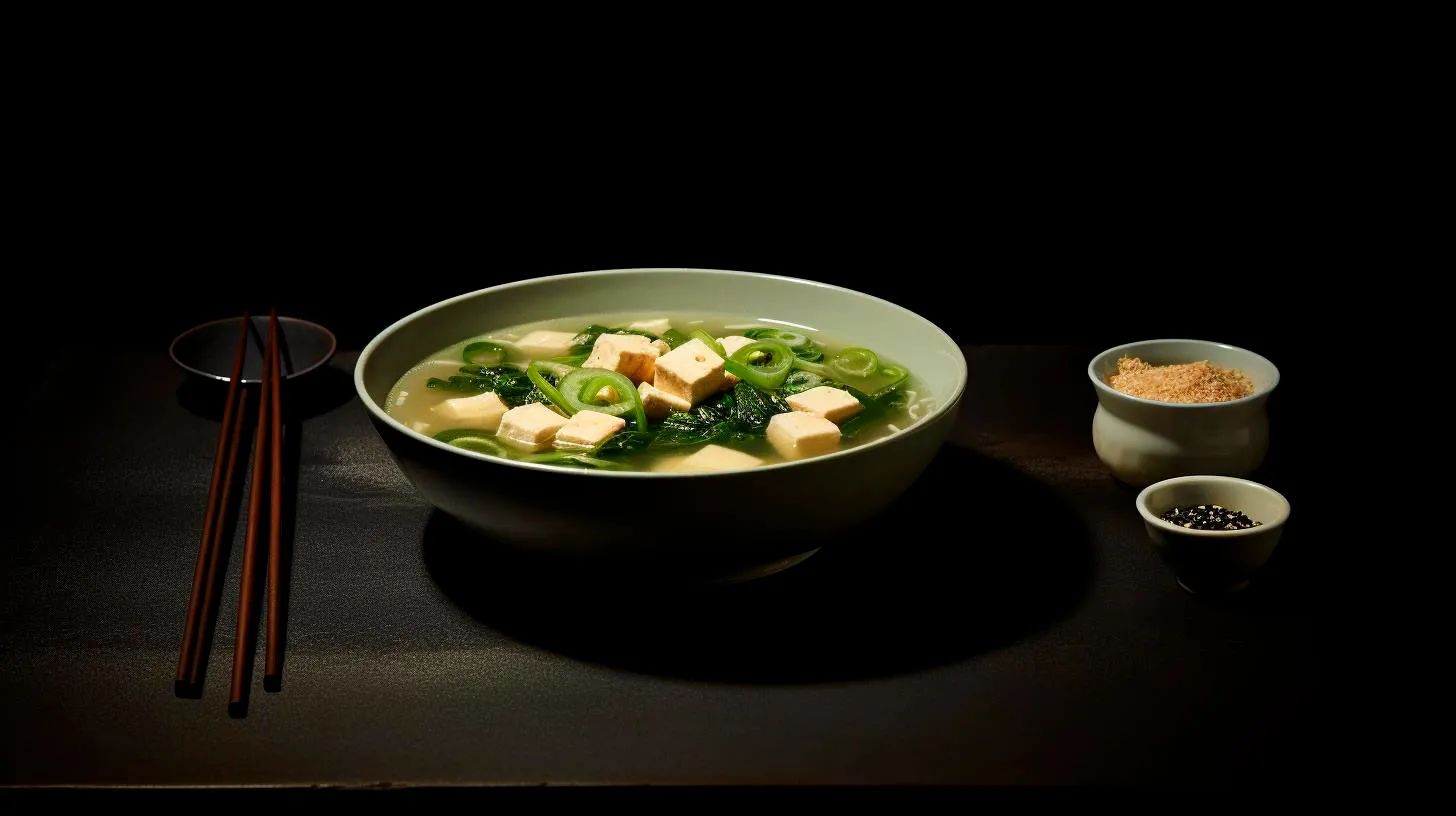How Seasonal Flavors Elevate the Taste of Sushi
In this article, we will explore how seasonal flavors elevate the taste of sushi and why it is worth indulging in this delightful culinary journey.
The Art of Seasonal Ingredients
Japanese cuisine has a deep-rooted tradition of using seasonal ingredients to create dishes that mirror nature’s rhythm. Sushi chefs embrace this philosophy by utilizing the freshest produce available during different times of the year. By doing so, they ensure that the flavors are at their peak, enhancing the overall sushi experience.
Some key advantages of incorporating seasonal flavors in sushi include:
- Enhanced taste: Seasonal ingredients are known for their exceptional taste as they are fresher, juicier, and bursting with flavor. Incorporating these ingredients in sushi elevates the taste profile, leaving diners craving more.
- Health benefits: Seasonal ingredients tend to be richer in nutrients, providing a range of health benefits. Whether it’s the vitamin C in citrus fruits during winter or the antioxidants in summer vegetables, sushi made with seasonal flavors can help nourish your body while tantalizing your taste buds.
- Environmental sustainability: Using seasonal ingredients supports sustainable farming practices and reduces the carbon footprint. By opting for sushi that reflects the flavors of the current season, you are not only treating yourself but also contributing to a more environmentally-friendly food system.
Seasonal Sushi Delights
The world of sushi is ever-evolving, with sushi chefs constantly experimenting with different flavor combinations to create exciting new tastes. Let’s explore some popular sushi options that excellently showcase seasonal flavors:
Spring:
During the spring, sushi chefs focus on incorporating fresh and delicate ingredients that symbolize new beginnings. Some popular seasonal sushi options during this time include:
- Cherry Blossom Roll: Inspired by the iconic cherry blossoms, this roll typically features pink-hued ingredients like pickled radish and crab. The gentle flavors and vibrant colors embody the essence of spring.
- Pea Shoot Nigiri: Spring is the perfect time to enjoy the vibrant green flavors of pea shoots. Delicately placed on a bed of sushi rice, this nigiri is refreshing and packed with nutrients.
Summer:
As temperatures rise, sushi chefs create sushi options that are light, refreshing, and perfect for warmer days. Here are a couple of sushi creations that capture the essence of summer:
- Watermelon Sushi: Watermelon’s juicy sweetness combined with fresh fish creates a unique sushi experience that perfectly embodies the flavors of summer.
- Cucumber Roll: With its cooling and crisp taste, the cucumber roll is a summer favorite. This roll is often paired with refreshing ingredients like avocado and mint to create a truly refreshing sushi roll.
Fall:
When autumn arrives, sushi chefs embrace the earthy and comforting flavors of the season. Here are a couple of seasonal sushi options that showcase the best of fall:
- Pumpkin Tempura Roll: With pumpkin in abundance during fall, this roll combines the sweetness of roasted pumpkin with a crispy tempura coating, creating a delightful contrast of textures.
- Autumn Salmon Nigiri: This nigiri highlights the rich flavors of salmon paired with autumnal ingredients like caramelized onions and a sprinkle of cinnamon, capturing the essence of fall in every bite.
Winter:
Winter brings a sense of warmth, and sushi chefs incorporate flavors that are comforting and hearty. Here are a couple of sushi options that perfectly capture the essence of winter:
- Warm and Spicy Tuna Roll: Packed with warmth and spice, this roll often features seared tuna combined with ingredients like ginger and chili. It creates the perfect blend of heat and comfort during colder months.
- Roasted Chestnut Maki: Roasted chestnuts bring a nutty and slightly sweet flavor to this maki roll, providing a delightful taste that perfectly complements the winter season.
Unlocking New Tastes
Seasonal flavors have the power to transform an already exceptional dish like sushi into something truly extraordinary. By incorporating the freshest ingredients that nature has to offer, sushi chefs infuse their creations with unique tastes, taking the overall experience to new heights.
Key takeaways:
- Seasonal ingredients enhance the taste of sushi, ensuring freshness and bursting flavors.
- Seasonal sushi options offer health benefits and contribute to a more sustainable food system.
- Exploring seasonal sushi allows you to experience different tastes throughout the year.
- Sushi showcases the artistry and creativity of Japanese cuisine, relying on the finest seasonal ingredients to bring joy to your palate.
So, the next time you indulge in sushi, embrace the beauty of seasonal flavors and embark on a culinary journey that not only satisfies your appetite but also celebrates the wonders of nature.
The Art of Incorporating Seasonal Ingredients into Sushi
In this article, we will explore the art of incorporating seasonal ingredients into sushi, highlighting its benefits and key takeaways.
Why Incorporate Seasonal Ingredients?
Using seasonal ingredients in sushi not only enhances the taste and presentation but also ensures the use of fresh, locally sourced produce. By choosing ingredients that are in season, sushi chefs can take advantage of the best flavors available at any given time of the year. Additionally, seasonal ingredients often come with various health benefits, making them a perfect addition to your sushi roll. Here are a few reasons why incorporating seasonal ingredients in sushi is a remarkable choice:
- Freshness: Seasonal ingredients are harvested at their peak, ensuring the highest quality and freshness.
- Flavor: Seasonal ingredients offer vibrant flavors that complement the other elements of sushi perfectly.
- Sustainability: Using local, seasonal ingredients reduces the ecological footprint and supports sustainable farming practices.
- Health Benefits: Different seasons bring different nutrients, providing a variety of health benefits to sushi enthusiasts.
Key Takeaways for Seasonal Sushi Ingredients
1. Embrace diversity:
The beauty of seasonal ingredients lies in their diversity. Each season brings a unique set of flavors and textures that can transform your sushi experience. Experimenting with a wide range of ingredients allows you to create an ever-changing menu that keeps customers excited and engaged.
Example: Incorporate summertime fruits like mango or watermelon for a burst of sweetness, or try using root vegetables such as parsnips or beets during the colder months to add a unique earthy flavor.
2. Harmonize with traditional elements:
While incorporating seasonal ingredients, it is essential to maintain the balance and essence of traditional sushi. The essence of sushi lies in its simplicity, highlighting the quality of the ingredients. The seasonal elements should complement the classic flavors and not overpower them.
Example: Pairing freshly caught salmon with thinly sliced spring radishes adds a refreshing crunch while harmonizing with the rich flavor of the fish.
3. Stay ahead of the trends:
By incorporating seasonal ingredients, sushi chefs have the opportunity to stay ahead of the culinary trends. By using trendy seasonal ingredients, you can offer unique and exciting sushi combinations that will set your establishment apart from others.
Example: For the winter season, introduce a sushi roll featuring roasted chestnuts to capture the cozy and comforting flavors that customers crave during colder months.
4. Highlight local produce:
Using local, seasonal ingredients fosters a sense of community and supports local farmers. Showcasing regional produce in your sushi rolls not only adds a personal touch but also appeals to customers who value sustainability and locally sourced ingredients.
Example: In coastal areas, incorporating locally sourced seaweed such as Nori or Dulse offers customers a taste of the region and supports seaweed farmers.
Final Thoughts
The art of incorporating seasonal ingredients into sushi allows chefs to continuously innovate and keep their menus fresh and exciting. By embracing the diversity of seasonal produce and harmonizing it with traditional sushi elements, chefs can create unique combinations that delight the palate. Not only does incorporating seasonal ingredients offer numerous health benefits, but it also supports sustainable practices and local communities. So, the next time you take a bite of sushi, appreciate the artistry behind incorporating seasonal ingredients and savor the flavors that each season brings.
Exploring the Relationship Between Freshness and Seasonality in Sushi
The Importance of Freshness in Sushi
In the world of sushi, freshness is paramount. The quality and taste of sushi greatly depend on the freshness of its ingredients, especially the fish. Eating sushi made with fresh ingredients ensures a delightful gastronomic experience that sushi lovers crave. Freshness directly affects the texture, flavor, and even the aroma of sushi, making it an essential aspect of this exquisite cuisine.
Proper handling and storage of fish are imperative to maintain its freshness. From the moment it is caught until it reaches the sushi bar, fish goes through rigorous steps to preserve its freshness. Chefs take great care and expertise in order to present the best possible sushi to their customers.
Here are some key takeaways to highlight the importance of freshness in sushi:
- Freshness is crucial for the taste, texture, and flavor of sushi.
- Proper handling and storage techniques ensure the preservation of fish freshness.
- High-quality sushi relies on the use of fresh ingredients.
The Role of Seasonality in Sushi
Sushi not only emphasizes freshness but also embraces seasonality. In traditional Japanese cuisine, the concept of “shun” refers to the seasonality and peak freshness of ingredients. Sushi chefs pay close attention to the seasonal availability of various fish and ingredients to create harmonious flavor combinations. This ensures that the sushi served is not only fresh but also at its peak flavor.
Traditional sushi restaurants in Japan embrace the practice of serving seasonal sushi. This allows the chefs to incorporate the best available ingredients, resulting in an ever-changing menu that showcases the diversity and flavors of different seasons. For example, fatty fish like tuna and mackerel are at their prime during certain seasons, providing sushi lovers with a unique dining experience.
Let’s summarize the significance of seasonality in sushi:
- Seasonal sushi offers the best flavor combinations by utilizing peak-fresh ingredients.
- Traditional sushi restaurants emphasize the importance of seasonality, resulting in an ever-changing menu.
- Sushi enthusiasts can enjoy unique dining experiences by trying seasonal sushi.
The Relationship Between Freshness and Seasonality
Freshness and seasonality go hand in hand in the world of sushi. The connection between these two factors is essential for creating exceptional sushi dishes. When sushi chefs incorporate fresh, seasonal ingredients into their creations, they elevate the overall quality and taste of the sushi.
Understanding the relationship between freshness and seasonality enables sushi enthusiasts to appreciate the artistry behind each sushi piece on their plate. By choosing seasonal sushi, diners can savor the flavors that nature offers during specific times of the year.
Here are some key takeaways to understand the relationship between freshness and seasonality in sushi:
- Freshness and seasonality work in tandem to create exceptional sushi dishes.
- Sushi chefs utilize fresh, seasonal ingredients to elevate the taste and quality of their creations.
- Choosing seasonal sushi allows diners to experience the unique flavors of each season.
Conclusion
Sushi is not just a culinary delight; it is an experience that combines freshness, seasonality, and skillful craftsmanship. The relationship between freshness and seasonality elevates sushi to a whole new level, where each bite tells a story of nature’s bounty. By understanding and appreciating the importance of freshness and seasonality in sushi, we can fully immerse ourselves in this ancient and exquisite Japanese cuisine.
Benefits of Using Seasonal Ingredients in Sushi
While sushi lovers are always on the lookout for new and exciting flavors, there is one aspect of this delicacy that is often overlooked – the use of seasonal ingredients.
Seasonal ingredients are those that are only available during certain times of the year. They are picked at their peak freshness, resulting in a more vibrant and flavorsome dining experience. Incorporating seasonal ingredients into sushi not only enhances the taste but also offers numerous benefits. Let’s dive into why using seasonal ingredients in sushi can greatly elevate your culinary experience.
1. Superior Flavor and Freshness
Seasonal ingredients are harvested at the right time when they are at their peak flavor. Using these ingredients in sushi allows you to enjoy the best flavors nature has to offer. For example, during the summer months, you can savor the sweetness of fresh, plump mangoes and juicy cucumbers in your sushi rolls. On the other hand, during winter, the rich and creamy texture of avocado can be paired perfectly with fish and other seafood. By using ingredients that are in season, you can ensure the freshness and exceptional taste of your sushi.
2. Nutritional Value
“You are what you eat,” they say, and that couldn’t be truer when it comes to sushi. Seasonal ingredients are packed with essential nutrients and offer greater nutritional value compared to out-of-season produce. For instance, during spring, asparagus is at its prime. It is low in calories, high in fiber, and rich in vitamins A, C, and K, making it a perfect addition to your sushi rolls. By incorporating seasonal ingredients, you not only enhance the taste but also provide your body with valuable nutrients.
3. Environmentally Friendly
Utilizing seasonal ingredients in sushi contributes to sustainable and environmentally friendly practices. When you use ingredients that are currently in season, you support local farmers and reduce the need for long-distance transportation. This reduces carbon emissions and helps in preserving the environment. Moreover, by consuming seasonal produce, you encourage crop rotation and biodiversity, promoting a healthier ecosystem. Making the choice to use seasonal ingredients in your sushi is an easy way to make a positive impact on the environment.
4. Cost-effective
Opting for seasonal ingredients in sushi can also be cost-effective. Unlike out-of-season produce, seasonal ingredients tend to be more abundant, resulting in lower prices. Additionally, purchasing ingredients locally and in-season can help you avoid import costs associated with out-of-season produce. Saving money without compromising on the quality and flavor of your sushi is a win-win situation for any sushi enthusiast.
5. Variety and Creativity
Using seasonal ingredients introduces a whole new level of variety and creativity into sushi making. With each season, a unique assortment of ingredients becomes available, allowing sushi enthusiasts and chefs to experiment with different flavors, textures, and combinations. This encourages innovation in sushi recipes and keeps the culinary experience fresh and exciting. By incorporating seasonal ingredients in your sushi, you can expand your palate and discover new and delightful flavors.
In conclusion, incorporating seasonal ingredients into sushi offers a multitude of benefits, including superior flavor and freshness, increased nutritional value, environmentally friendly practices, cost-effectiveness, and enhanced variety and creativity. By embracing the seasons and exploring the unique ingredients they offer, you can elevate your sushi dining experience to new heights. So, the next time you indulge in sushi, seize the opportunity to savor the freshest and most flavorful ingredients that the season has to offer.



